8 Must-Eat Dishes and Snacks in Shanghai
Shanghai is not just the biggest and richest city of China, but also a foodie's paradise paralleling no other. There are a host of luxury hotels roaring in the city, housing some of the fanciest restaurants and lounge bars. However, Shanghai is also home to a dazzling variety of the most popular foods from all over China and especially brimming with local snacks. This article has selected 8 best and most popular local dishes for you to sample the authentic Shanghai cuisine.
Xiaolongbao is a traditional snack popular across China that is impossible to resist for any foodies, while Shanghai gets a very famous brand for it, Nanxiang Xiao Long Bao. Different from the ordinary steamed buns you will see in China, Xiaolongbao gets a lovely mini size wrapped by a thin skin of dough and filled with juicy gravy.
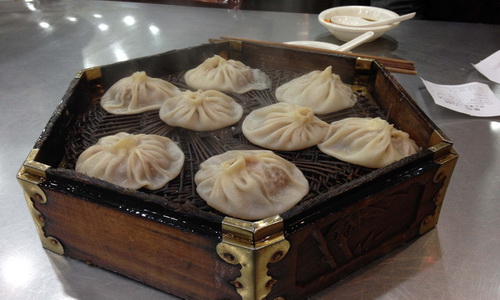
Xiaolongbao is rich in their flavors on account of their varied fillings, such as pork, shrimp, veggies and mushrooms. When you take a bite of the mini baos, your tongue will be washed by the delicious smelling soup, but be cautious for the first bite as the boiling gravy might get your lips scalded. The right way to enjoy a Xiao Long Bao is to take a nibble on the skin to release the juice first, and then eat it with some side vinegar sauce.
If you like Chinese dumplings, you would definitely fall in love with Guotie in Shanghai. Guotie is actually a kind of pan-fried dumplings with crispy and juicy skin. Guotie has thicker and tougher wraps to withstand the slow frying, while the fillings are unctuous and tender mixed with minced pork, onions, garlics and gingers. They are made into flat-bottomed double-horned shape so that they could be fully fried.
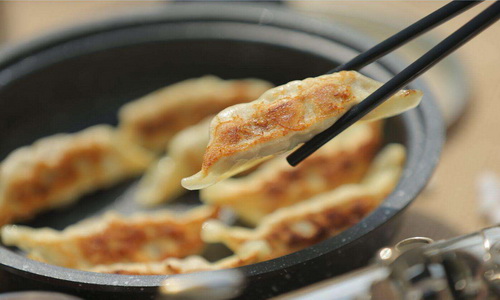
The skin tastes smooth and chewy, wile the middle and bottom would be salty and oily. Usually there will be chili sauce or brown sauce to dip them for a stronger taste. You can find Guotie from street-side stalls in most food or snack quarters like the City God Temple, and usually you may need to stand to enjoy it since the stalls have no seat. However, it is a part of Shanghai street food experience.
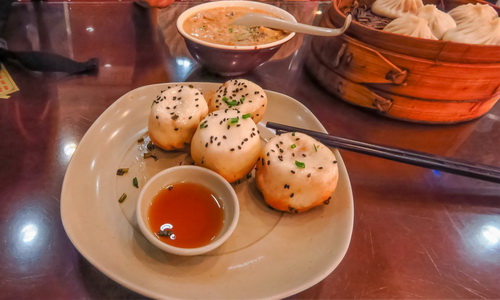
If you've never tried the Sheng Jian Bao, you barely know much about Shanghai culinary culture. Shengjianbao is actually a kind of stuffed buns fried in a large and shallow griddle, which is one of the most favored and classic street foods in Shanghai. They are a bit similar to Xiaolongbao since they have nearly the same fillings like pork or beef, but they are cooked in a very different way. Tightly arrayed on the griddle, the buns are slowly fried by a thin layer of oil in the bottom with a bit water poured over the top layer. Then the stuffed buns will be sprinkled with chopped scallions and sesame seeds for additional aroma. They are really tasty especially the crunchy crisp-fried bottom and chewy top.
Aka Congyou Banmian in Chinese, Scallion Oil Noodles is a simple dish that could be easily cooked in a home kitchen, but it is still a classic street food that tourists must try once in Shanghai. It is made of tender hand-pulled noodles that will be boiled thoroughly and cooled down in cold water. The highlight of this dish is the frying julienned scallion sauce that will be finally topped onto the noodles. Mixed with the sauce, all the noodles would be coated with the dark oil and the sweetness of the fried scallions, making every stand taste slippery and smooth.
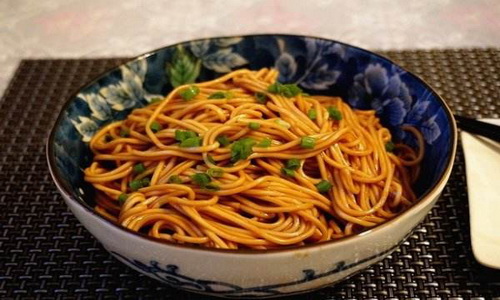
For extra flavors, one could also add the vinegar or chili sauce for better mouthfeel. You can find this home-style dish in most dining places of Shanghai, and even some high-end restaurants would offer them as a staple food in the end.
Guihua Lianou is probably the finest and most attractive street foods that one cannot help giving it a try. An entire section of lotus root is slowly brewed in a light sugar syrup for hours, with sticky rice stuffed into its interior tubes until rice plumps up to fill the long tubular spaces. With a deep red-brown color, they looks rather unimpressive when they are complete, but you will be astounded by its distinctive patterns when slicing it into centimeter-thick pieces. Once sliced, the vendors will pour some hot honey syrup drizzled with osmanthus that adds extraordinary fragrance. You can have it as a street food when you walk about the neighborhood alleys, or enjoy it as an appetite or dessert in an official banquet in Shanghai.
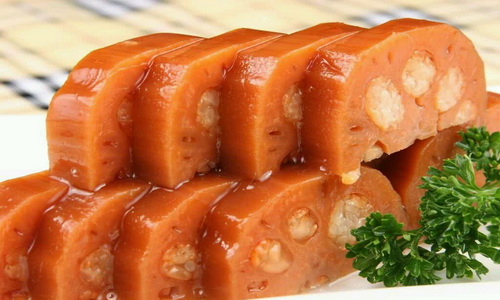
Literally oily blocks, Youdunzi is an old Shanghai snack that nearly vanishes in large commercial areas, but they could still be found in some back lanes and snack street. Youdunzi is a fried radish cake that tastes quite crispy and crunchy. They are easy to make, but the equipment is hard to get. The core tool for the cooking is a long-handled metal tin used to contain the flour starch mixed with shredded radish and chopped scallions. Dip the tin into bubbling hot oil and hold on the handle till the paste is browned on both sides. The out-of-pot fried cake would be placed on a rack for dripping and cooling, and then they would be topped with salted chili sauce and bean paste to enhance the flavors.
Congyoubing is no doubt one of the oldest and most popular dishes in Shanghai, as you could usually see locals queuing up long to buy it as breakfast. Flaky and crispy, the pancakes are made of dough rolled into a spiral mingled with green scallions, nubbins of fat pork and oil. They are flattened and pan-fried so that one can enjoy the flaky layers and crunchy texture. Sometimes, the vendors will add a fried egg on one side of the pancake for a succulent taste. In the City God Temple snack quarters, you could see many Congyoubing vendors doing their street food businesses from their kitchen doorways, and just follow the local’s line to seek the most authentic ones.
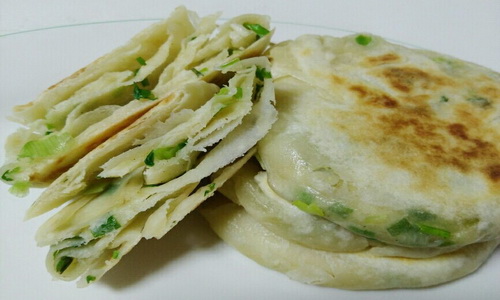
Malatang is a traditional street food originated from Sichuan Province but massively prevalent around the country. Shanghai version of Malatang is much refined by using less chili and retaining the natural flavor the ingredients. It is a bowl of spicy broth filled with various vegetables, meats, noodles, tofu, fish balls, meatballs, etc. In many restaurants, Malatang is served in a do-it-yourself way. You will be offered a big bowl and pick your favorite ingredients from the fridge on your own. And then they will cook it in the way how you want to spice your soup. Just be careful for your choice of the spice, because even little spice in Chinese terms may be quite overwhelming for westerners to get numbing lips.









